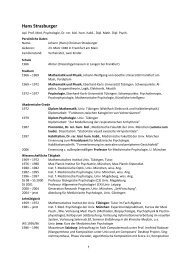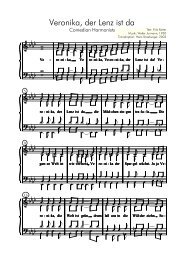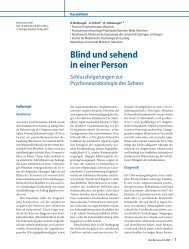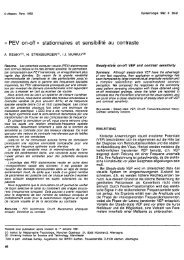Peripheral vision and pattern recognition: a review - strasburger - main
Peripheral vision and pattern recognition: a review - strasburger - main
Peripheral vision and pattern recognition: a review - strasburger - main
You also want an ePaper? Increase the reach of your titles
YUMPU automatically turns print PDFs into web optimized ePapers that Google loves.
<strong>Peripheral</strong>_Vision.doc<br />
Rumelhart, 1981); d) “prothesis <strong>and</strong> methathesis”, adding non-existent letters to a word on the<br />
left or right (rare); e) shortening of the perceptual image in a certain area in the visual field (p.<br />
65–70); f) assimilation of details to the perceived whole; g) false cognitive set, e.g. the impact of<br />
prior knowledge of font <strong>and</strong> letter case, <strong>and</strong> whether the syllables are meaningful or not. Four of<br />
these phenomena (a, b, e, f) are related to or underlie the crowding effect as we conceive it<br />
today – as the impairment of discriminating detail or recognizing a <strong>pattern</strong> in the presence of<br />
other details or <strong>pattern</strong>s. Some are reflected in formal theories of <strong>pattern</strong> <strong>recognition</strong> (a, b1, c,<br />
g). The others are still awaiting integration into future theories.<br />
The phenomenon of crowding was probably familiar to ophthalmologists soon after the<br />
introduction of acuity measurements but was first explicitly described by the Danish<br />
ophthalmologist Ehlers (Ehlers, 1936, p. 62; Ehlers, 1953, p. 432 7 ). Ehlers noted, in the context<br />
of normal reading <strong>and</strong> use of letter acuity charts, that there are visual, non-cognitive difficulties<br />
of recognizing letters among other letters in eccentric <strong>vision</strong>. He also observed that the number<br />
of letters recognized is independent of angular letter size at varying viewing distance (p. 62).<br />
Stuart <strong>and</strong> Burian (1962) later referred to the phenomenon described by Ehlers as the<br />
“crowding effect”.<br />
Further early work on the crowding effect was carried out by Davage <strong>and</strong> Sumner (1950) on the<br />
effect of line spacing on reading. Müller (1951) used a matrix of 15×15 Snellen E’s, <strong>and</strong> Prince<br />
(1957, p593) somewhat airily mused that “there is a psychological element which obviates the<br />
known laws of optics in the <strong>recognition</strong> of <strong>pattern</strong>s”.<br />
Averbach <strong>and</strong> Coriell (1961) started modern research on both crowding (which they called<br />
lateral masking) <strong>and</strong> spatial visual attention. They used Sperling’s (1960) iconic memory<br />
paradigm but controlled visual attention within a row of letters by marking one with an enclosing<br />
circle (Figure 19a) – a spatial cue or probe in modern terms (they called it a circle indicator).<br />
They also used a pointing line which they referred to as bar marker <strong>and</strong> which later became<br />
known as a symbolic cue. Both markers had the desired attention-attracting effect. However,<br />
the circle, unlike the bar, also had the effect of decreasing perceptual performance. Averbach<br />
<strong>and</strong> Coriell thus discovered contour interaction <strong>and</strong> motivated Flom’s well-known work which<br />
was published shortly thereafter (1963a; 1963b) (Figure 19b).<br />
The crowding effect is highly important for the underst<strong>and</strong>ing of amblyopia <strong>and</strong> eccentric <strong>vision</strong>,<br />
where it is particularly pronounced, whereas it is small <strong>and</strong> often seems to be absent in normal<br />
foveal <strong>vision</strong>. It is therefore surprising that it was first quantitatively described in normal foveal<br />
7 "When one is testing amblyopic children with isolated letters or E’s, the visual acuity recorded is often much<br />
better than with the ordinary test chart. If the visual field is crowded with letters, the area of the visual field in which<br />
the letters can be recognized narrows. This is very easy to demonstrate, as I showed at the Congress of Sc<strong>and</strong>inavian<br />
Ophthalmologists in 1936."<br />
50






